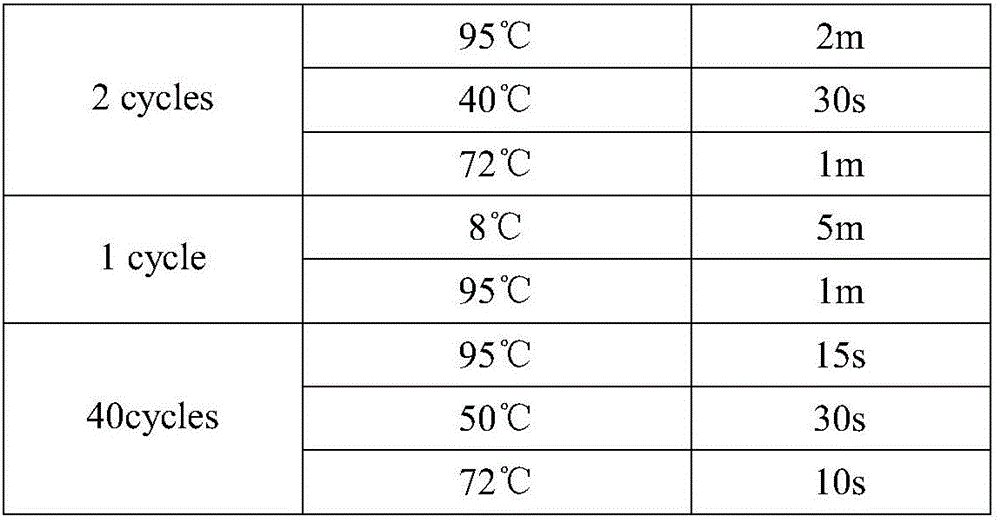Kit for detecting metastatic castration resistant prostate cancer (mCRPC) drug resistance
A castration-resistant, prostate cancer technology, applied in the field of immunoassay detection, can solve the problem of maintenance for 1.5 to 4 years, and achieve the effects of improved sensitivity, sensitive detection, and enhanced probe sensitivity
- Summary
- Abstract
- Description
- Claims
- Application Information
AI Technical Summary
Problems solved by technology
Method used
Image
Examples
Embodiment 1
[0037]Embodiment 1PSA-oligonucleotide probe
[0038] (1) Aldehyde modification of oligonucleotide probes
[0039] 50 nmol of Oligo1 (oligonucleotide) was prepared into a solution with 0.1 M pH 7.4 phosphate buffer. Weigh 500nmol of SFB (N-succinimidyl 4-formylbenzoate), dissolve it with anhydrous DMF (N,N-dimethylformamide), react at room temperature for 2.5h, and purify through a column to obtain Oligo -FB (aldehyde modified oligonucleotide).
[0040] Detection of the concentration of Oligo-FB: detection of A by Nanodrop spectrophotometer 260 The calculated value of Oligo-FB is 0.63nmol / μL.
[0041] Detection of aldehyde group modification rate: Use quantitative 2-hydrazinopyridine-2-hydrochloride solution to detect the aldehyde group modification rate. Take the above-mentioned Oligo-FB and add it to the 2-hydrazinopyridine-2-hydrochloride solution, shake and mix well, and react at 37°C for 1 hour. The absorbance value at 360nm detected by Nanodrop is 1.4, and the modific...
Embodiment 2
[0054] The QPCR amplification specific detection of embodiment 2Oligo molecule
[0055] Oligo1-13 molecules were diluted to three concentrations of 25000 molecules / μl, 83333 molecules / μl and 250000 molecules / μl. Then, taking Oligo1-3 as an example, mix Oligo1-3 at the same concentration to obtain mixed samples A, B, and C, as shown in Table 2.
[0056] Table 2 Example 2 sample formula
[0057]
[0058] The above samples were configured with QPCR amplification solution according to Table 3 to obtain a QPCR amplification kit, and then Oligo1-3 was subjected to QPCR amplification according to the procedures shown in Table 4, and Oligo1-3 in mixed samples A, B, and C Each was subjected to QPCR amplification, using the extended Oligo1-3 as a template, and the Ct values of the amplification results are shown in Table 5. Among them, the extension primer is RT-P, its 3' end is complementary to the 3' end of the oligonucleotide, the 5' end can form a hairpin structure, and the m...
Embodiment 3
[0072] Embodiment 3 makes standard curve
[0073] The same result can be obtained with Oligo1-13. In order to simplify the process, the following examples use Oligo1-3 as an example.
[0074] According to the steps of Example 1, Oligo2 was modified with SFB having a molar equivalent of 5 times to obtain Oligo-FB, and PSMA was modified with a hydrazine group of SANH having a molar equivalent of 10 times to obtain PSMA-SANH, and the molar ratio was 10:1 PSMA-Oligo2 was obtained after reacting Oligo-FB with PSMA-SANH at room temperature for 16 hours.
[0075] According to the steps of Example 1, Oligo3 was modified with SFB with a molar equivalent of 20 times to obtain Oligo-FB, and PSMA was modified with hydrazine groups with SANH with a molar equivalent of 50 times to obtain PSMA-SANH, and the molar ratio was 8:1 PSMA-Oligo3 was obtained after reacting Oligo-FB with PSMA-SANH at room temperature for 24 hours.
[0076] PSA-Oligo1, PSMA-Oligo2 and PSMA-Oligo3 were subjected to ...
PUM
 Login to View More
Login to View More Abstract
Description
Claims
Application Information
 Login to View More
Login to View More - R&D
- Intellectual Property
- Life Sciences
- Materials
- Tech Scout
- Unparalleled Data Quality
- Higher Quality Content
- 60% Fewer Hallucinations
Browse by: Latest US Patents, China's latest patents, Technical Efficacy Thesaurus, Application Domain, Technology Topic, Popular Technical Reports.
© 2025 PatSnap. All rights reserved.Legal|Privacy policy|Modern Slavery Act Transparency Statement|Sitemap|About US| Contact US: help@patsnap.com



